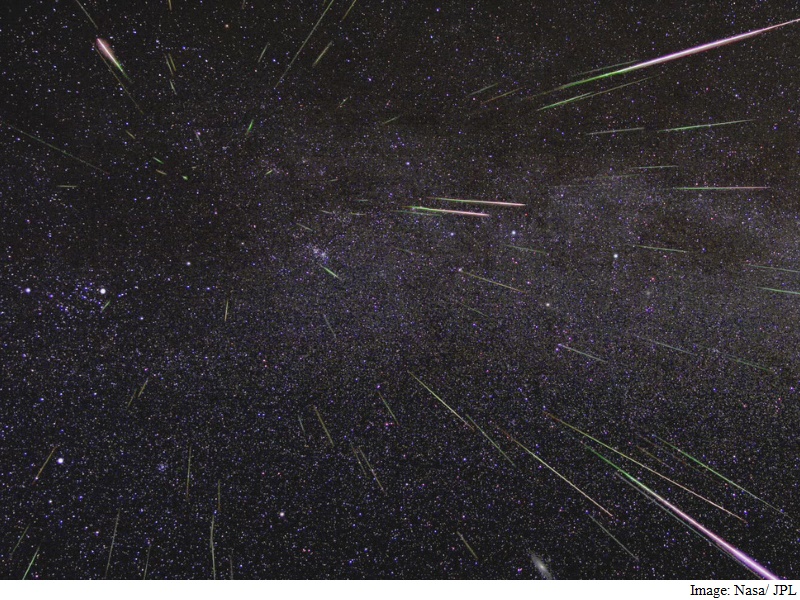- Home
- Science
- Science News
- Perseid Meteor Shower to Light Up the Skies This Week: Nasa
Perseid Meteor Shower to Light Up the Skies This Week: Nasa

"Forecasters are predicting a Perseid outburst this year with double normal rates on the night of August 11-12," said Bill Cooke from Nasa's Meteoroid Environments Office in the US.
The Perseids show up every year in August when Earth ventures through trails of debris left behind by an ancient comet.
This year, Earth may be in for a closer encounter than usual with the comet trails that result in meteor shower, setting the stage for a spectacular display.
"Under perfect conditions, rates could soar to 200 meteors per hour," said Cooke.
An outburst is a meteor shower with more meteors than usual. The last Perseid outburst occurred in 2009.
Every Perseid meteor is a tiny piece of the comet Swift-Tuttle, which orbits the Sun every 133 years. Each swing through the inner solar system can leave trillions of small particles in its wake.
When Earth crosses paths with Swift-Tuttle's debris, specks of comet-stuff hit Earth's atmosphere and disintegrate in flashes of light.
These meteors are called Perseids because they seem to fly out of the constellation Perseus.
Most years, Earth might graze the edge of Swift-Tuttle's debris stream, where there is less activity.
Occasionally, Jupiter's gravity tugs the huge network of dust trails closer, and Earth ploughs through closer to the middle, where there is more material.
This may be one of those years, Nasa said. Experts agree that three or more streams are on a collision course with Earth.
"The meteors you'll see this year are from comet flybys that occurred hundreds if not thousands of years ago," said Cooke.
"They have travelled billions of miles before their kamikaze run into Earth's atmosphere," he said.
The best way to see the Perseids is to go outside between midnight and dawn on the morning of August 12.
"Allow about 45 minutes for your eyes to adjust to the dark. Lie on your back and look straight up. Increased activity may also be seen on August 12-13," Nasa said.
Perseid meteors travel at the blistering speed of 59 kilometres per second.
At that speed, even a smidgen of dust makes a vivid streak of light when it collides with Earth's atmosphere. Peak temperatures can reach anywhere from 1,600 to 5,500 degrees Celsius as they speed across the sky.
The Perseids pose no danger to Earth. Most burn up 80 km above our planet. However, an outburst could mean trouble for spacecraft.
Get your daily dose of tech news, reviews, and insights, in under 80 characters on Gadgets 360 Turbo. Connect with fellow tech lovers on our Forum. Follow us on X, Facebook, WhatsApp, Threads and Google News for instant updates. Catch all the action on our YouTube channel.
Related Stories
- Samsung Galaxy Unpacked 2025
- ChatGPT
- Redmi Note 14 Pro+
- iPhone 16
- Apple Vision Pro
- Oneplus 12
- OnePlus Nord CE 3 Lite 5G
- iPhone 13
- Xiaomi 14 Pro
- Oppo Find N3
- Tecno Spark Go (2023)
- Realme V30
- Best Phones Under 25000
- Samsung Galaxy S24 Series
- Cryptocurrency
- iQoo 12
- Samsung Galaxy S24 Ultra
- Giottus
- Samsung Galaxy Z Flip 5
- Apple 'Scary Fast'
- Housefull 5
- GoPro Hero 12 Black Review
- Invincible Season 2
- JioGlass
- HD Ready TV
- Laptop Under 50000
- Smartwatch Under 10000
- Latest Mobile Phones
- Compare Phones
- Honor Win RT
- Honor Win
- Xiaomi 17 Ultra Leica Edition
- Xiaomi 17 Ultra
- Huawei Nova 15
- Huawei Nova 15 Pro
- Huawei Nova 15 Ultra
- OnePlus 15R
- Asus ProArt P16
- MacBook Pro 14-inch (M5, 2025)
- OPPO Pad Air 5
- Huawei MatePad 11.5 (2026)
- Xiaomi Watch 5
- Huawei Watch 10th Anniversary Edition
- Acerpure Nitro Z Series 100-inch QLED TV
- Samsung 43 Inch LED Ultra HD (4K) Smart TV (UA43UE81AFULXL)
- Asus ROG Ally
- Nintendo Switch Lite
- Haier 1.6 Ton 5 Star Inverter Split AC (HSU19G-MZAID5BN-INV)
- Haier 1.6 Ton 5 Star Inverter Split AC (HSU19G-MZAIM5BN-INV)

















